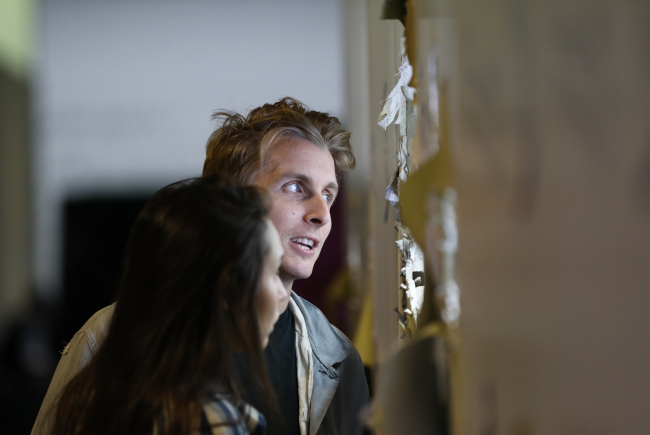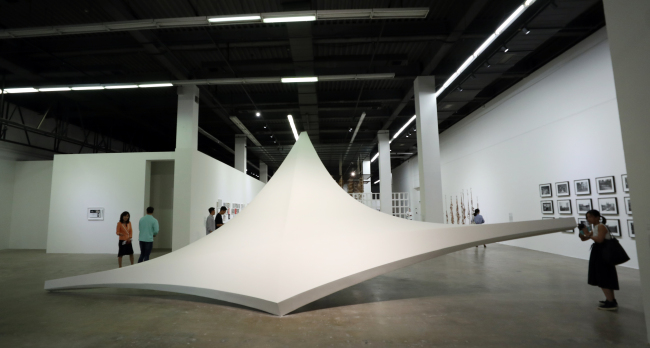The 12th edition of the Gwangju Biennale kicked off Friday, with 165 artists from 43 countries participating.
A curatorial collective of 11 independent curators put together this year’s biennale.
“The most important point was the process, the ways in which artists build up the biennale. The curators have tried to have conversations with each other as much as they could and also to make the exhibition relatable to the city and the local people here,” said Kim Sun-jung, Gwangju Biennale Foundation president, during a press conference ahead of the opening of Asia’s leading art biennale.
This year’s Gwangju Biennale took inspiration from Benedict Anderson’s 1983 seminal work titled, “Imagined Communities,” and, like Anderson who defined a nation as a culturally, socially and politically “imagined community,” the participating artists explore how borders are constructed and imagined today.

A visitor takes a look inside Miao Ying’s 2017 work “Chinternet Plus: What Goes on” at Gwangju Biennale Exhibition Hall on Thursday. (Yonhap)
History is a major keyword for this year’s biennale as it features the history of the city and also Gwangju Biennale, which was founded in 1995 to honor the city’s1980 pro-democracy uprising and commemorate the citizens’ sacrifice during the uprising that was brutally suppressed by paramilitary troopers.
It may be no coincidence that the title of this year’s event, “Imagined Borders,” resonates with the title of the inaugural biennale, “Beyond the Borders.”
“Returns,” a section curated by David Teh, features the first four editions of the Gwangju Biennale. Designed like a walk-in magazine, to use the curator’s word, this section summarizes the legacy of the early days and serves as a venue for performances and lectures.
Memory is also rekindled in a section curated by Chung Yeon-shim and Yeewan Koon at the Asia Culture Center where Cuban artist Kcho’s “In Order to Forget,” winner of the Grand Jury Prize in 1995, is exhibited.
GB Commission is an independent program that is designed to shed new light on the history of the city of Gwangju. As part of the inaugural GB Commission, Apichatpong Weerasethakul, Mike Nelson and Kader Attia were commissioned to install their works at the former Armed Forces’ Gwangju Hospital and a church nearby.
Nelson, who represented Britain at the Venice Biennale in 2011, removed mirrors from the main hospital buildings and reconfigured them in the church. By hanging the mirrors -- “the witness of accumulated time, encoded tablets charged with histories they had seen, photographic document never fixed“ as the artist call them -- Nelson turn the now vacant church into a place of worship and solace.
Artists Attia and Weerasethakul also explore the traumatic memories associated with the main military hospital building.
Artist Back Seung-woo’s photographs of the former Armed Forces’ Gwangju Hospital and Gwangju 505 Security Unit are also shown at the lobby space of former South Jeolla Provincial Government Office.
Main exhibitions at Gwangju Biennale Exhibition Hall, Asia Culture CenterThe first exhibition at the main hall focuses modern architectural works, shedding light on how they have become powerful tools in unshackling the past and imagine a new future. Clara Kim, a senior curator of international art at Tate Modern, has brought together works that unveil notable modernist architecture and socio-political functions they performed in the second half of the 20th century.

An installation view of Gwangju Biennale Exhibition Hall Gallery 1, curated by Clara Kim, a senior curator of international art at Tate Modern, Thursday. (Yonhap)
The section includes Terence Gower’s case study of US embassies built in Saigon and artists Lais Myrrha and Louidgi Beltrame’s separate works based on their studies of works by acclaimed architect Oscar Niemeyer. The exhibition is at Gwangju Biennale Exhibition Hall Gallery 1.
At Gwangju Biennale Exhibition Hall Gallery 4, Christine Y. Kim and Rita Gonzalez from the Los Angeles County Museum of Art have co-curated a section exploring the post-internet conditions. The exhibition looks at places where access to the internet is restricted or censored and how politics and the digital divide play out in those countries.
Gridthiya Gaweewong, artistic director of the Jim Thompson Art Center, has organized “Facing Phantom Borders” at Gwangju Biennale Exhibition Hall Gallery 2 and 3. Dedicated to exploring geopolitics in Southeast Asia, works by 25 artists explore issues of borders and forced migration.
Chung Yeon Shim, an associate professor at Hongik University, and Yeewan Koon, an associate professor at the University of Hong Kong, have curated “Faultlines” as Asia Culture Center.
Also at the center is “The Art of Survival: Assembly, Sustainability, Shift” jointly curated by Kim Sung-woo, Kim Man-seok and Paek Chong-ok. Artist Kang Suki Seo-Kyung’s video installation titled “Black Mat Oriole,” a nine-minute film of performance based on a royal court dance of Joseon, is among the works on exhibition here.
North Korean ArtDrawing the curiosity of the general public, a section dedicated to North Korean art at ACC is a chance to see artworks from the communist neighbor to the north.
The 22 North Korean art pieces presented makes this exhibition the largest of its kind here. Curated by US-based BG Muhn, the exhibit features part of a collection from the Mansudae Art Studio’s Beijing branch and the US-based Yedo Arts Foundation.
By Shim Woo-hyun (ws@heraldcorp.com)







